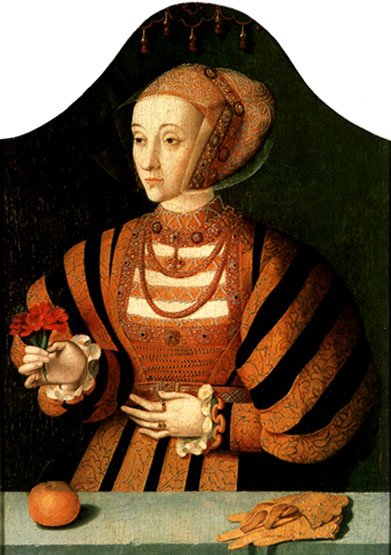Anne of Cleves. Painitng by Barthel Bruyn the Younger.
It seems unfair that Anne of Cleves, the fourth wife of King Henry VIII, is known throughout history as the “ugly” wife (out of the six total he had) when in reality, it was her wit and intellect that makes her remarkable.
Born in Dusseldorf in 1515, Anne of Cleves was the daughter of Maria of Julich-Berg and Johan III, Duke of Cleves. Her marriage to Henry in Jan. 6, 1540, right from the start was fraught with disappointment and misunderstanding.
First, at the tender age of 24, she was invited to become Henry’s fourth bride based on a painting the king commissioned of her countenance which he later said looked nothing like her. But that came a bit later.
The marriage was a political arrangement fostered by Henry’s “fixer,” Chief Minister Thomas Cromwell who sought to temper the power plays of Spain and France while boosting Protestant influence with the union.
First meeting
The first meeting between the king and his bride was a massive fail, as Anne rejected Henry’s surprise meeting wearing a disguise and the relationship went downhill from there.
The complaints began in earnest then as the king complained she did not look like the commissioned portrait.
He called her a “Flanders Mare,” said she smelled, and reportedly refused to have marital sex with her.
Anne was a fish out of water in Tudor Court. Her upbringing did not include dancing and music, the heart of Tudor life, but was focused on learning duties of a noblewoman she was expected to become along with household skills.
In an attempt to integrate herself into life with Henry, perhaps nervous over what lay ahead, she had the foresight to socialize with her English travelers to learn customs and social skills as well as learning the king’s favorite card games during her voyage to meet him.
There is little known about Anne’s feelings about the marriage but she was keenly aware that two of Henry’s first three wives were either banished or beheaded and that the purpose of any union was to produce a male heir for the king.
And although Henry had his coveted son through his third wife, Jane Seymour, who died shortly after giving birth, he was forging ahead with the fourth marriage to secure another.
End of marriage
Seven months after his marriage to Anne, who served as queen consort, Henry notified his bride their marriage was to be annulled three days hence. His reasoning was the marriage was never consummated and for good measure threw in questions about Anne’s relationship years ago with her brief engagement to Francis the Duke of Bar in 1527.
Wisely, Anne knew that arguing or pleading to continue the marriage would not be successful and instead fully cooperated with the king’s wishes. Certainly, she had nothing to lose and as it turned out she gained beautifully.
Henry, possibly relieved over Anne’s cooperation, awarded her with a generous settlement, granted her the title of “the King’s Sister” as long as she remained in England and bestowed upon her large tracts of properties, such as Hever Castle – the former childhood home of Henry’s second wife, Anne Boleyn, whom he had beheaded in 1536.
Unlike Henry’s first wife, Catherine of Aragon, who resisted the king’s demand for annulment on religious grounds, ending up banished from court until her death in 1536, Anne was allowed to keep her jewels, her metal plate and her dresses, and received a generous annual stipend along with revenue from other properties.
She willingly turned over her wedding ring to Henry, asking that it be destroyed “as a thing which she knew of no force or value.”
Henry seemed to value Anne’s counsel after their separation and continued a cordial relationship with her until he died in 1547.
Later years
At that point Anne lost her title of the “King’s Sister” and she moved away from court, leading a quiet life until Mary I, Henry’s daughter with his first wife, Catherine of Aragon, and Anne’s stepdaughter, took the throne in 1553. Anne briefly came under suspicion when a plot to depose the queen and place Elizabeth I on the throne was investigated because Anne also had a close relationship with Elizabeth I, the daughter of the king and Anne Boleyn.
She escaped a charge of treason and remained cordial with Mary I until her death in 1557 at the age of 41 after a brief illness in Chelsea Old Manor, her home and former home of Catherine Parr, Henry’s sixth and last wife.
The site has been offering a wide variety of high-quality, free history content since 2012. If you’d like to say ‘thank you’ and help us with site running costs, please consider donating here.
References
https://www.thirteen.org/wnet/sixwives/meet/ac_handbook_children.html
https://www.theanneboleynfiles.com/the-death-of-anne-of-cleves/
https://www.historytools.org/stories/anne-of-cleves-the-unwanted-queen-who-survived-and-thrived
https://www.english-heritage.org.uk/visit/inspire-me/blog/blog-posts/henry-viii-and-anne-of-cleves/
https://www.britannica.com/biography/Anne-of-Cleves-queen-of-England


